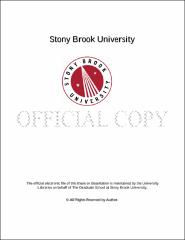| dc.identifier.uri | http://hdl.handle.net/11401/77584 | |
| dc.description.sponsorship | This work is sponsored by the Stony Brook University Graduate School in compliance with the requirements for completion of degree. | en_US |
| dc.format | Monograph | |
| dc.format.medium | Electronic Resource | en_US |
| dc.language.iso | en_US | |
| dc.publisher | The Graduate School, Stony Brook University: Stony Brook, NY. | |
| dc.type | Thesis | |
| dcterms.abstract | This thesis serves as an investigation of the Elizabethan villain and the ways this character contributes to the ongoing dialogue concerning morality. Through the examination of the evolution of evil, villainy, and morality via Shakespeare's villains Richard and Iago, one can conclude that Shakespeare's contribution to the discussion of evil, which still goes on today, is that evil is a part of human nature. Not only are his villains humorous and entertaining, but Richard and Iago are relatable, pitiful, and raise questions about the evil inherent in human nature. These characters challenge the way Renaissance audiences habitually thought about right and wrong because Richard and Iago represent the best and worst of society. They are intelligent, brave, and demonstrate rhetorical sophistication unparalleled, but they are also ruthless, violent, and manipulative. Because Shakespeare's villains embody both good and evil, they are a contradiction, an oxymoron, a reflective pool by which we can see our true selves. These characters reflect the past medieval vice and prepare drama for the hero-villains of the Romantics. It is because of their complexity that Richard and Iago are able to pose some important questions: is it ever morally justifiable to use evil to accomplish a goal? What happens to a person when he pretends to be something he is not? And finally, why is evil so attractive? This last question is arguably the most important question as it serves as the fuel for this study. What is it about the villain, the character who chooses to enact evil, which makes him not only attractive to the other characters in the play but to the audience as well? | |
| dcterms.available | 2017-09-20T16:52:56Z | |
| dcterms.contributor | Huffman, Clifford | en_US |
| dcterms.contributor | Videbaek, Bente | en_US |
| dcterms.creator | Staehle, Jennifer Katherine | |
| dcterms.dateAccepted | 2017-09-20T16:52:56Z | |
| dcterms.dateSubmitted | 2017-09-20T16:52:56Z | |
| dcterms.description | Department of English. | en_US |
| dcterms.extent | 51 pg. | en_US |
| dcterms.format | Monograph | |
| dcterms.format | Application/PDF | en_US |
| dcterms.identifier | http://hdl.handle.net/11401/77584 | |
| dcterms.issued | 2014-12-01 | |
| dcterms.language | en_US | |
| dcterms.provenance | Made available in DSpace on 2017-09-20T16:52:56Z (GMT). No. of bitstreams: 1
Staehle_grad.sunysb_0771M_12146.pdf: 435317 bytes, checksum: 756f7afee759e444be1c38e96fdf4d40 (MD5)
Previous issue date: 1 | en |
| dcterms.publisher | The Graduate School, Stony Brook University: Stony Brook, NY. | |
| dcterms.subject | Evil, Iago, Morality, Richard III, Shakespeare | |
| dcterms.subject | Literature | |
| dcterms.title | Shakespeare's Evil: From Vice to Villain | |
| dcterms.type | Thesis | |

